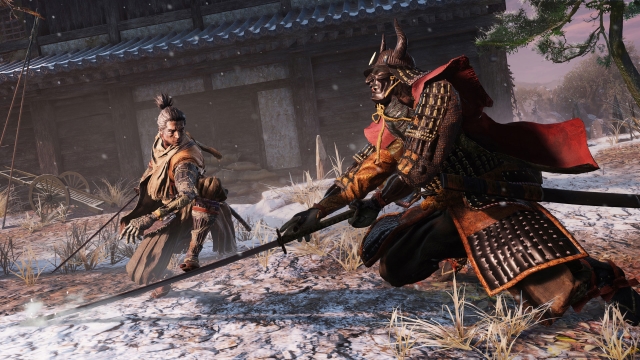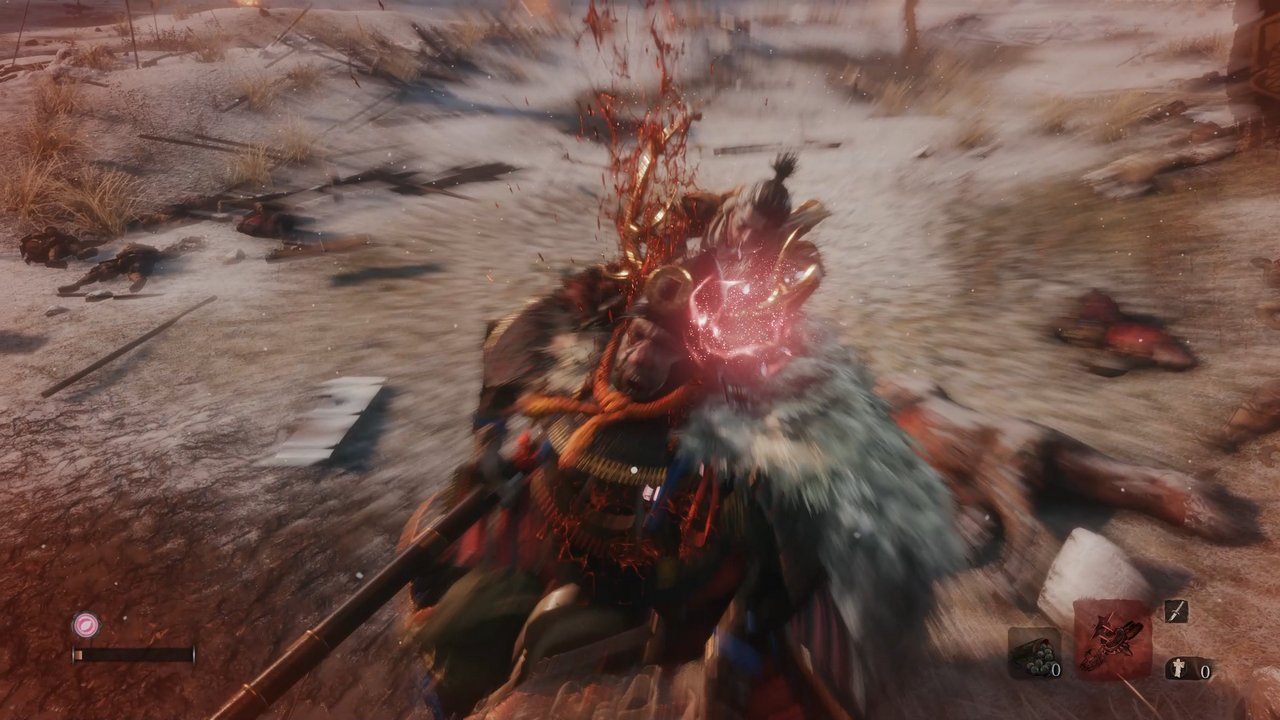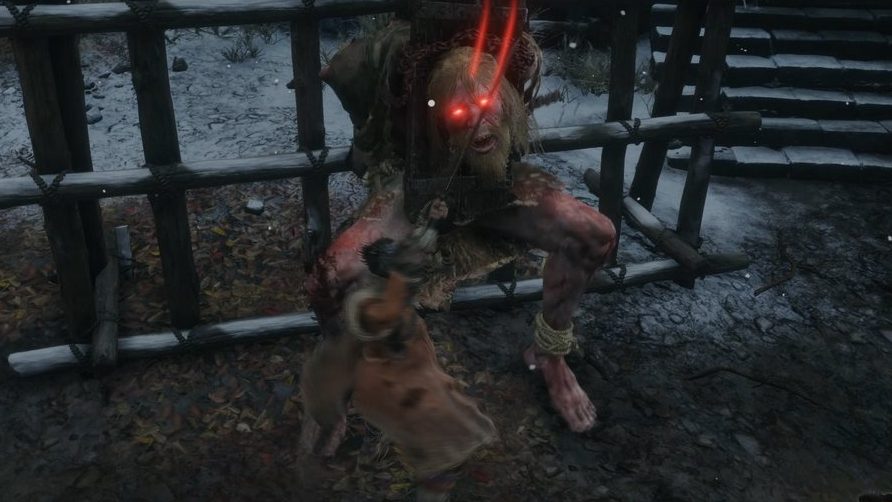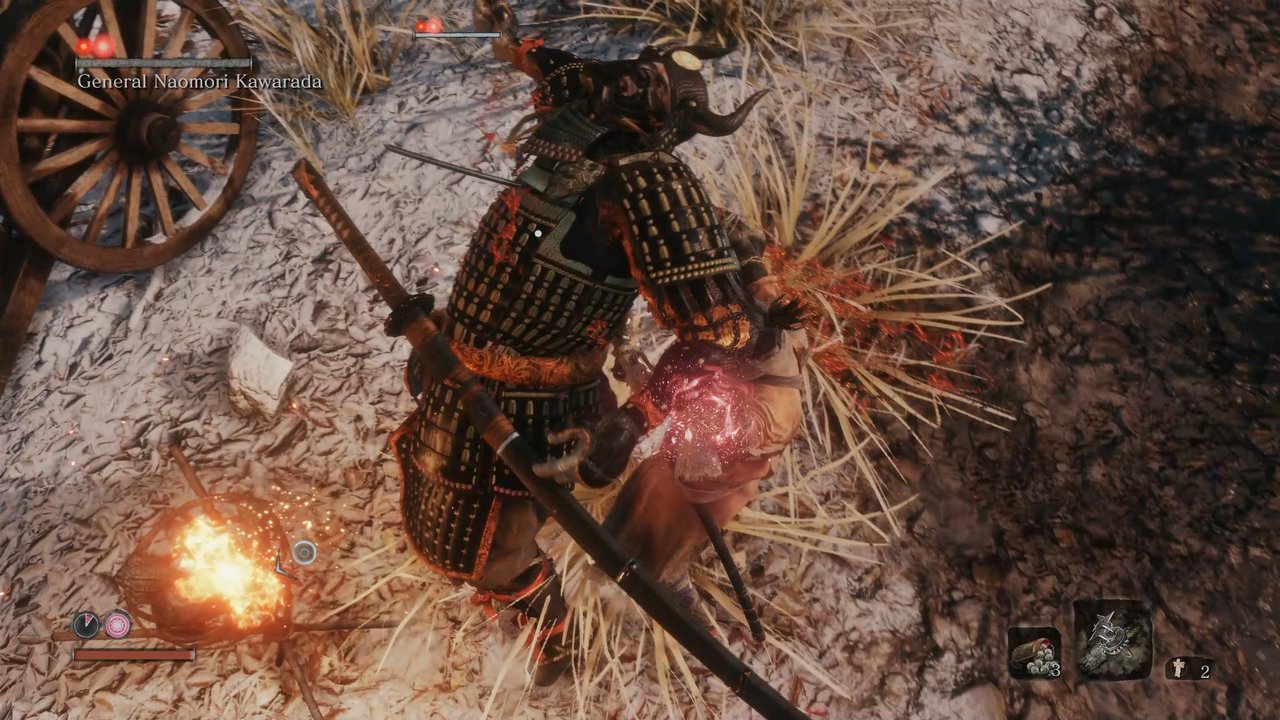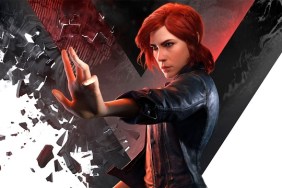Sekiro Shadows Die Twice is From Software’s take on Feudal Japan, and places you in the role of Sekiro, a Shinobi Ninja, as he tries to rescue his master. It’s the most un-Soul-like Souls-like yet and puts a new spin on the formula that made From Software a household name. In doing so, it forges a path that makes it feel uniquely its own. Bloodborne was basically Dark Souls in Victorian England, but Sekiro is far from just the same thing set in Feudal Japan.
However, for all its newness, Sekiro made me long for Dark Souls more than once. In some ways, the new and changed gameplay systems feel like they’re a step sideways or backward instead of being an evolution. While I enjoyed my time in Sekiro, I wouldn’t crown it From’s best work.
Sekiro Review | The one-armed wolf
In the role as Sekiro, you find yourself in the midst of the downfall of the Ashina Clan. Your master, the Divine Heir Kuro, is kidnapped by Genichiro Ashina. Genichiro hopes that he can use Kuro’s divine Dragon Blood to create an immortal army. Though Sekiro tries to rescue Kuro, Genichiro cuts his arm off and leaves him for dead.
Three years later Sekiro awakes in a dilapidated temple and finds an old sculptor has fitted him with the Shinobi Prosthetic, a powerful tool that replaces his arm that can be fitted out with powerful tools and skills. Sekiro also finds he was able to survive his wounds three years before by Kuro’s intervention and that he now has the Dragon Heritage and divine blood flowing through him.
It’s a very Japanese story, and it’s one of From Software’s best yet. Previous From Software games have doled the story out in cryptic little dollops, and you usually had to read between the lines and really seek out the lore. In Sekiro, the story is a lot more coherent and up front.
You’ll still have to pay close attention to get everything out of the game storywise, though. Many NPCs have fascinating stories that will only be revealed in their entirety if you are persistent in checking in with them and doing side quests that fulfill their needs. Some are as simple as finding a common item and bringing it to them. Other quests require quite a bit of commitment, and the requirements are more obscure.
Sekiro is always pretty good about letting you know how to move both the main story and side stories forward, though. Even if it doesn’t tell you where an item is you need, you can usually look around and talk to people until you get a pretty good general idea of what you need to do. However, there are still no waypoints, only a simple map that shows the general locations of the world, and the mechanics of how to actually accomplish your mission are left strictly up to you.
Sekiro Review | Dead, dead again
Death has always been a big part of playing From Software’s games, but in Sekiro it’s finally made its way into a game mechanic. Since Sekiro has divine blood, he has the ability to revive himself. Getting killed no longer means you go straight back to a checkpoint (this time around these are Sculptor’s Idols instead of bonfires). Instead, as long as you have a resurrection charge, you can instantly come back to life with half of your health.
Even with this new resurrection mechanic, the game is still brutal, but it allows you a small reprieve when an enemy downs you. Your foes don’t know you can just spring back to life, so when they kill you, they’ll start meandering back to their posts. When they turn their backs, you can spring back to life and get a quick stealth kill in. Since the number of times you can revive yourself is limited, this doesn’t become too much of a crutch. In fact, if anything the game is harder than previous From Software games.
When you run out of resurrection charges, the game behaves much like other From games. You’ll return to the nearest idol and enemies will respawn. However, there is are penalties to Sekiro’s restorative powers. You’ll lose half your current skill XP and money if you’re forced to respawn, but there are more far-reaching effects than just that. If you die too much, a disease known as Dragonrot will begin to spread. Dragonrot is the result of Sekiro using the life force of others to revive. This disease can affect any NPC in the game and manifests with coughing and wheezing.
Dragonrot won’t kill any of the NPCs (at least as far as I’ve seen), but it does make completing their questlines impossible. Fortunately, there’s a way to reverse Dragonrot, so you’re never stuck in a situation where you have to start a new game to get everything the story has to offer. However, since Dragonrot is not permanent, it made me question what the purpose was in the first place. There’s nothing to really lose from NPCs getting Dragonrot. Since you can just cure the disease, I assume it’s only there for lore purposes.
Sekiro Review | Perfect posture
One of the most significant differences between Sekiro and previous From Software games is the combat. In Sekiro, you only have a katana as your primary weapon, and there is no armor or shields, so the emphasis is placed on parries and a potent offense. You’re encouraged to stay on the attack, which almost anathema to a Dark Souls player.
The slow, methodical combat of Dark Souls has been replaced by something a bit more frantic in nature. There’s no stamina bar in Sekiro, so you’re allowed to go wild with attacking and defending. Instead of stamina, there’s a new posture meter. When this fills up for either you or the enemy, a posture break will occur, which leaves the subject open to a devastating strike.
Most of your kills in Sekiro won’t actually come from draining a foe’s vitality. The lower an enemy’s life is, the easier it is to break their posture, but you don’t necessarily worry about draining their health. Each attack you parry, block, or land on a blocking enemy, it uses up posture, which depletes faster than health. If you keep the pressure on an enemy by attacking without relent, their posture will break, and you can perform a deathblow, which gives you an instant kill.
At first, this system is counterintuitive for From Software game veterans because it’s the opposite of what you usually want to do. However, after an hour or so, it becomes second nature and is quite satisfying. It made me feel a lot more capable in the first part of the game than I did when I first played Dark Souls or Bloodborne. Additionally, in-game tutorials ease you into the basics pretty smoothly. Then, about an hour in, the game drops you flat on your ass in your first “real” mini-boss encounter.
Sekiro Review | Extra cheesy
The Chained Ogre mini-boss is a perfect example of the issues with Sekiro‘s game design. In Dark Souls and Bloodborne, the boss fights always leaned towards tough but fair. You might have a hard time with a battle, but by finding the right combo of gear, observing your enemy, and perfecting your strategy, you could come out on top.
Most of the bosses I faced in Sekiro were more about finding the right cheese factor. The Chained Ogre is the first difficulty spike in the game, and he seems designed to totally wreck you and dissolve any belief in a fair fight. For one, his weakness is fire. This is hinted at by NPCs and loading screen tips. However, when you reach the Ogre, you likely don’t have the Fire Vent Prosthetic Tool you need.
Instead, you need to talk to an NPC you find on the way to the Chained Ogre to get a bell, go back to the Dilapidated Temple and use the bell to be transported three years into the past, then happen to search the right bonfire. Then you have to take the thing you get there back to the Dilapidated Temple, have it installed in your prosthetic arm, then you can use it against the Ogre.
Except, the recommended weapon isn’t really the best way to take out the Ogre. You can use it to stun him and you can make the effect last longer if you douse him in oil first, but it’s a limited use thing. If you die, you’re out of oil and have to collect more Spirit Emblems (or buy them via the Sculptor’s Idol menu) to power your Fire Vent tool. Instead, of putting up with all this, the best strategy is just to cheese the Ogre by taking advantage of his AI.
The best way to kill the Chained Ogre is simple: dodge left, dodge left, swipe, swipe, swipe. That’s all. You just repeat that over and over. Sometimes, you might want to dodge right, but this is really all it takes. This easy cheese would be fine, except that tactic (or a small variation thereof) works on almost every boss. There’s a few that you have to use a different strategy for, but Sekiro plays way too hard into the cheese factor, and not enough into making boss fights interesting experiences that challenge the player on multiple levels.
Sekiro Review | I got killed by Genichiro Ashina and all I got was this stupid sword
Part of what plays into the issue above is that you can’t equip new weapons or armor. In Dark Souls the equipment systems let you customize your playstyle considerably. You could be a heavily armored brute who carries a gigantic greatsword, or a nimble rogue in leather armor with a short sword. Just changing equipment gave you access to new tactical options and allowed you a ton of different approaches to an enemy.
Sekiro does get a plethora of skills and buffs via various upgrade trees, but because your primary weapon remains the same and your Prosthetic Tools are limited in use, you’ll find yourself using primarily the same strategies throughout the game.
Leveling up has been simplified as well. To level up your attack level and vitality you have to use items that you get from beating bosses and mini-bosses as well, so you can’t grind. This means it’s very easy to get stuck at a boss and not have any options left besides just crashing into them and dying over and over until you figure out what cheese tactic they’re weak to. Sekiro doesn’t give you the options Dark Souls and Bloodborne do as far as different character builds or leveling, and so you’re a lot more limited in your approach to combat.
Sekiro is a game that rewards twitch gameplay more than methodical combat and character building, and as such it’s not going to appeal to all fans of From Software’s previous games. It’s not like the combat isn’t good. I think as a whole it’s the best in the series so far, it’s just that there are not many options available to enjoy it. I wish they had made some of Sekiro’s Prosthetic Tools into full-fledged weapons instead of powerful ammunition-dependent attacks. Having just the spear and ax as primary weapons would have added some needed options to the game’s combat system.
Also, a minor problem with combat is that sometimes your lock-on to an enemy will just drop and you’ll just be screwed as the camera stops tracking them. I also had instances, especially when facing the Burning Bull mini-boss, where I was against the wall, and the camera decided just to rotate straight up. In a game like Sekiro which demands precision and attention, this is a death sentence.
Sekiro Review | Beautiful world
Sekiro has one of the most cohesive worlds to date in a From Software game. There are some absolutely beautiful areas, all connected by branching pathways, and Sekiro’s grappling abilities mean you get to see everything from a ton of different angles.
From Software outdid themselves with world design, and even the smallest out of the way little corners of Sekiro have artistic touches. You may grapple across tree limbs and jump down to isolated rocks and look up to see elaborate stone carvings from some long dead Buddhist monk. I encourage everyone who plays to really check out an area once you’ve cleared it of enemies. Not only are there a ton of secrets and hidden items, but the environment should just really be appreciated when you have a calm moment.
Even the enemies themselves have a lot of great visual variety. I’m so used to games using the same basic grunt enemy that I was really impressed with the variety of foot soldiers in Sekiro. Some have just swords; others have a sword and torch, some attack with axes, others have shields. Not only does this give a more realistic feel to the world, but each of these enemies requires different tactics to beat, so it keeps you on the edge of your seat.
Sekiro Review | From breaks the Souls mold
Sekiro is a great game. Despite my complaints with its boss fights and the elimination of the equipment system Dark Souls was known for, it was a challenging and exciting adventure through Feudal Japan. If you’re a From Software fan, it’s a must-buy game, even with the changes, and it’s a decent place to start even if you’ve never played a From game before.
However, Sekiro is far from perfection. I respect From’s decision to strike out from its comfort zone and really change up things with this game, and I hope the studio continues to experiment in future games. If Sekiro is indicative of the future of From Software, I’m excited to see its next game. Hopefully, it will be an Armored Core.
-
Combat is furious and rewards skill.
-
Good enemy variety keeps it from getting boring between bosses.
-
Great world design.
-
Best story in a From Software game yet.
-
Bosses require a bit too much cheese to defeat.
-
Lock-on and camera sometimes go haywire.

